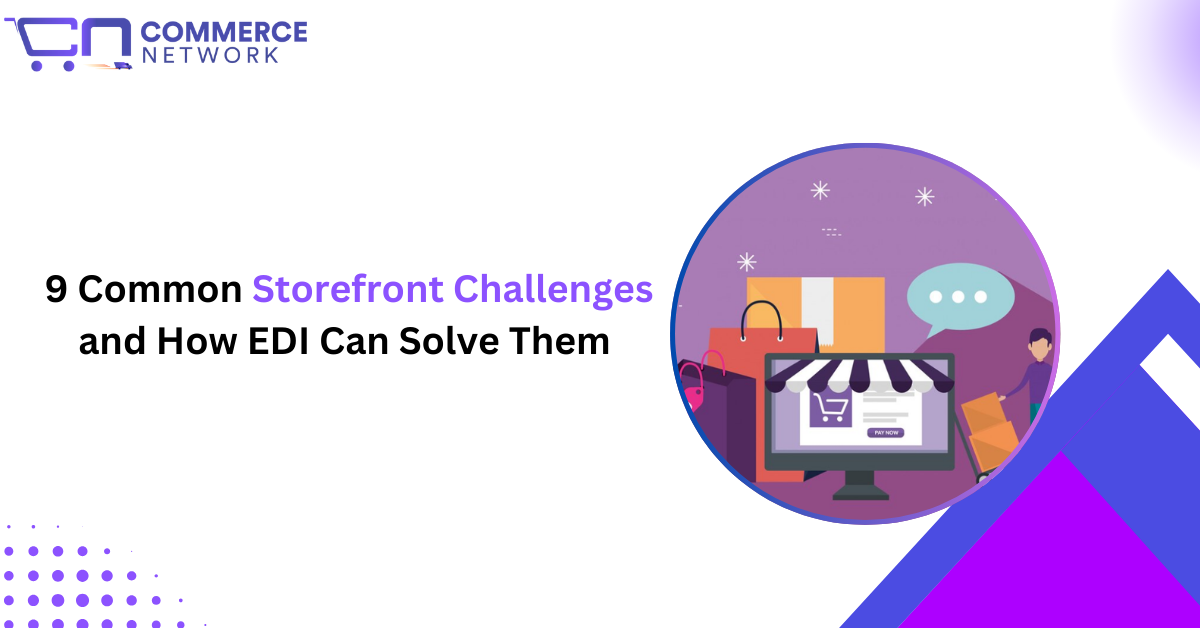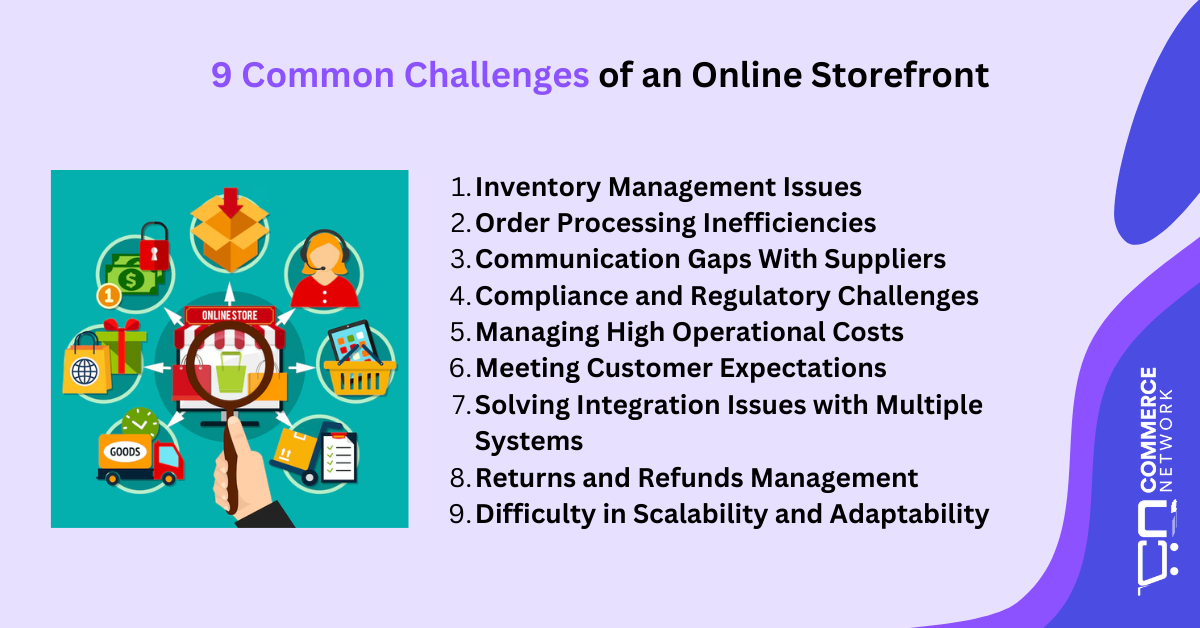By Bipin Dhungana | March 12, 2025

Key Highlights:
Solves Inventory & Order Issues: EDI automates stock updates and order processing using documents like EDI 846 and EDI 850, cutting down delays, stockouts, and human errors.
Streamlines Supplier Communication: Standard EDI formats ensure clear, real-time exchanges (e.g., EDI 855, 856, 810), avoiding miscommunication and delays in shipping or invoicing.
Boosts Compliance & Lowers Costs: EDI helps meet retailer and regulatory requirements through built-in checks and pre-configured templates while also reducing manual labor and processing errors.
Enables Easy Scaling: With cloud-based EDI, storefronts can grow without infrastructure strain, handle more partners, and integrate with ERP, WMS, and APIs for future-ready operations.
Electronic commerce through online storefronts is frequently riddled with several common challenges that negatively impact the business in the long term.
Among the many methods of resolving these challenges, the use of Electronic Data Interchange (EDI) is a crucial one, especially if the business is involved in large-scale B2B, B2G, and B2C transactions.
Here are 9 common challenges of an online storefront and how EDI helps solve these challenges.
Problem: Overstocking or Stockouts
Maintaining the right inventory levels while dealing with delayed updates, manual tracking, disjointed systems, and slow communication is a struggle. This is likely to cause overstocking or understocking, leading to increased holding costs, lost sales, and dissatisfied customers.
EDI-enabled Solution
EDI, with documents like EDI 846 Inventory Advice, enables real-time inventory visibility by automating updates between suppliers, warehouses, and sales channels. For example, when a product is sold online, EDI instantly deducts it from inventory counts and triggers replenishment alerts.
Suppliers receive automated purchase orders, ensuring timely restocking. This "just-in-time" approach reduces holding costs and prevents stockouts.
Problem: Manual Order Handling
Many storefronts still rely on manual order processing. Manual order entry is time-consuming and prone to errors. Misplaced emails, incorrect product codes, and delayed approvals slow fulfillment and strain supplier relationships, and poor customer experiences.
EDI-enabled Solution:
EDI automates order processing from start to finish. When a customer places an order, the system generates an EDI 850 (purchase order) and sends it directly to the supplier. The supplier’s system auto-acknowledges the receipt (via EDI 855), confirms availability, and schedules shipping. This is done all without human intervention, reducing order cycle times from days to minutes, and minimizing errors.
Also, EDI integration with Warehouse Management Systems (WMS) ensures orders are picked, packed, and shipped efficiently.
Problem: Inconsistent Communication Formats And Lack of Real-Time Updates from Suppliers
Inconsistent communication formats (e.g., emails, spreadsheets, faxes) lead to misunderstandings, delayed responses, and incorrect shipments. And a disorganized and delayed communication process between suppliers and storefronts results in miscommunication, waste of time, higher costs, and disruptions in the supply chain.
EDI-enabled Solution:
EDI standardizes communication through universal document formats (e.g., ANSI X12 or EDIFACT). Suppliers and retailers exchange structured data, ensuring clarity and consistency.
Additionally, EDI enables direct, real-time communication with suppliers. The EDI 856 (Advanced Shipping Notice) provides shipment details in advance, allowing businesses to prepare for incoming inventory. EDI 810 (Invoice) automates invoicing, reducing payment delays and disputes.
Problem: Difficulty in keeping up with Compliance and Partner Requirements
E-commerce businesses must comply with tax laws, industry regulations, and retailer-specific mandates. Large retailers and distributors often mandate strict EDI compliance for onboarding. Manual tracking of compliance requirements is complex and increases the risk of non-compliance. Non-compliance, on the other hand, risks lost partnerships or financial penalties.
EDI-enabled Solution:
EDI providers offer pre-configured templates aligned with retailer-specific requirements (e.g., Amazon’s EDI guidelines). Compliance checks are built into workflows, ensuring adherence to formatting, data fields, and response times. This simplifies onboarding and avoids costly penalties.
The use of EDI ensures businesses comply with industry standards by automating data exchange in required formats. Retailers using EDI 820 (Payment Order/Remittance Advice) can manage financial transactions securely.
Problem: Inefficient, Error-prone, and Labor Intensive Processes Making Expenses Increase
Manual data entry, paper-based invoices, and slow order processing increase operational costs. Businesses spend time and resources correcting errors, following up on orders, and managing returns.
EDI-enabled Solution:
By automating transactions, EDI significantly reduces labor costs and errors. Fewer errors mean lower return rates and resource wastage. The EDI 812 (Credit/Debit Adjustment) streamlines financial adjustments, minimizing disputes. Automation with EDI leads to fewer errors, faster payments, and reduced administrative overhead.

Problem: Delayed Deliveries and Incorrect Orders Enhancing Customer Frustrations
Customers expect fast, accurate deliveries. Errors in order fulfillment or slow processing times can lead to negative reviews, customer frustrations, and cart abandonment.
EDI-enabled solution:
EDI 856 (Advanced Shipping Notice) provides customers with tracking details, while EDI 940 (Warehouse Shipping Order) and EDI 945 (Warehouse Shipping Advice) streamline logistics. This accelerates fulfillment by automating order-to-delivery workflows. And faster order fulfillment leads to better customer satisfaction.
Problem: Effectively Connecting Multiple Disconnected Systems
Many businesses with an online storefront operate multiple software solutions like ERP, WMS, CRM, Accounting, etc. that do not communicate well with each other. This lack of integration and communication creates bottlenecks and data inconsistencies.
EDI-enabled solution:
EDI acts as a bridge between different systems, ensuring smooth data exchange. An EDI-integrated storefront can automatically sync order details, inventory updates, and shipping confirmations across multiple platforms.
Problem: Difficulty Maintaining a Structured Return And Refund Process
Returns management that involves the returns of goods purchased and refunds from the storefront can be chaotic without a structured process, leading to lost inventory and customer dissatisfaction.
EDI-enabled Solution:
With EDI 180 (Return Merchandise Authorization Request and Approval), businesses can automate the return process, reducing errors and improving efficiency. It helps track returned products and issue refunds promptly.
Problem: Reducing Manual Processes and Growing Business Without Losing Efficiency
Expanding a storefront often means handling more orders, suppliers, and customers. Without automation, and efficient control over operations, scaling leads to increased workload and inefficiencies.
EDI-enabled solution:
EDI, especially cloud-based EDI solutions like that of Commerce Network, support business growth by streamlining operations. These EDI solutions help businesses scale effortlessly by scaling with the business, supporting unlimited partners and transactions.
Additionally, APIs integrate EDI with emerging technologies like IoT and blockchain, future-proofing operations. For example, SMEs using cloud EDI can expand globally without upfront IT investments.
From inventory optimization to customer satisfaction, EDI addresses the core challenges faced by modern storefronts. By automating workflows, standardizing communication, and enabling real-time data exchange, EDI empowers retailers to operate efficiently, scale confidently, and deliver exceptional customer experiences.
Improve Your B2B, B2G, and B2C Ecommerce?
Integrate EDI For Efficiency, Compliance, and Scalability?
Just Curious About EDI?
Give Us A Call
202-280-7060